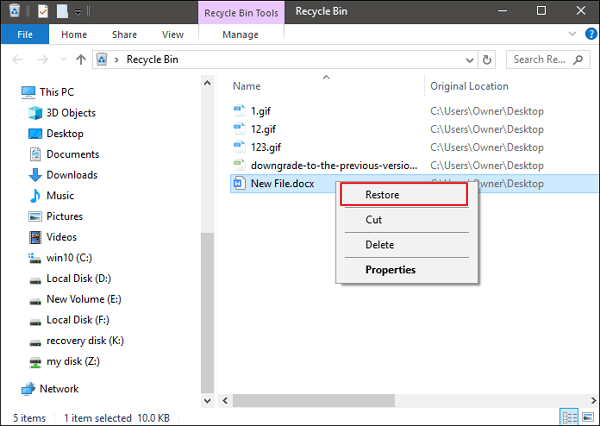

- #RECOVER LOST WORD FILES WINDOWS 10 UPDATE#
- #RECOVER LOST WORD FILES WINDOWS 10 PC#
- #RECOVER LOST WORD FILES WINDOWS 10 OFFLINE#
- #RECOVER LOST WORD FILES WINDOWS 10 DOWNLOAD#

Unless you’ve made a mistake in writing the command, type Y to begin the recovery process. The prompt Continue? (y/n) will appear in the command line. Once the command is written, press Enter. Winfr C: D: /regular /n “\Users\Me\Downloads\my photo.jpg” If any of the file or folder names contain spaces, the whole path must be between quotation marks, like in the example below: Winfr C: D: /regular /n \Users\Me\Downloads\myphoto.jpg Edit this command based on your own drive names and file paths.įor example, if your file got deleted from drive C, is being recovered to drive D, and is titled myphoto.jpg, a Regular command could look like this:

In the placeholder above, X is the source drive, Y is the destination drive, and the latter end of the command-including NameOfUser and Folder-indicates the path to the file’s location before deletion. Winfr X: Y: /regular /n \Users\NameOfUser\Folder\File.type Here is the basic command syntax for Regular recovery:

But if they’ve been deleted for a while or were part of a corrupted disk, Extensive mode is probably the best option.Ĭhoose the Regular mode if your files have recently been deleted and Extensive mode if they’ve been lost for a while (Image credit: Microsoft) Step 3: Write a Regular command Generally, Regular mode is recommended for recently deleted files. A command prompt will appear with a pre-written overview of the two available recovery modes-Regular and Extensive-and some command syntax examples.īefore proceeding, decide whether your recovery requires Regular or Extensive mode. Step 2: Choose either Regular or Extensive modeĪfter installing the Windows File Recovery app, open it from the Start menu.
#RECOVER LOST WORD FILES WINDOWS 10 PC#
If your PC isn’t formatted into two or more internal drives, you can connect an external hard drive or USB stick. You won’t be able to save files to the drive they were deleted from. The other is the destination drive, where your files will be restored. One is the source drive, where your files were originally saved. Sometimes your deleted files are easily restored from your Recycle Bin (Image credit: Microsoft) Step 1: Have a destination drive readyįor your Windows File Recovery command to work, you’ll need at least two different drives to work with.
#RECOVER LOST WORD FILES WINDOWS 10 UPDATE#
You should ideally be on the Windows update or higher.
#RECOVER LOST WORD FILES WINDOWS 10 DOWNLOAD#
If your files aren’t found via the Recycle Bin or File History, download the free Windows File Recovery app from your Microsoft Store and follow the steps below. Locate your lost files, choose a version to recover, and click Restore. You should have a view of previous versions of folders and files in this location. To use File History, go to the files’ original folder in File Explorer, select the Home tab, and click History. You can activate File History via File History Settings by selecting your recovery drive and clicking Turn on File History.
#RECOVER LOST WORD FILES WINDOWS 10 OFFLINE#
This feature must already be activated for your files to be recoverable, and you need to already have a backup saved on an external drive such as a USB drive or on a network drive.įurthermore, it only backs up files saved in the Music, Videos, Pictures, Documents, and Desktop folders as well as offline OneDrive files. If the files aren’t in the Recycle Bin-because they’ve been permanently deleted using Ctrl+Shift+Delete, for example-try the File History tool. The files should now show up in their original folders. If you find them there, right-click them and press Restore. Start by checking your Recycle Bin for the deleted files.


 0 kommentar(er)
0 kommentar(er)
